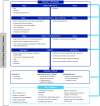Understanding Treatment Burden for Children Treated for Growth Hormone Deficiency
- PMID: 28386679
- PMCID: PMC5605605
- DOI: 10.1007/s40271-017-0237-9
Understanding Treatment Burden for Children Treated for Growth Hormone Deficiency
Abstract
Objective: Growth hormone deficiency (GHD) treatment for children requires growth hormone injections, typically administered daily until the child reaches adult height. Child GHD treatment burden is not well understood and no disease-specific measures exist to assess this burden. The purpose of the study was to explore GHD treatment burden for children and their parents by conducting concept elicitation interviews supporting a theoretical model of the impact of GHD treatment.
Methods: Four focus groups (in Germany) and 52 telephone interviews (in the UK and USA) were conducted with children/adolescents with GHD aged 8 to <13 years and parents of children with GHD aged ≥4 to <13 years. The purpose of the interviews was to understand the experience of GHD treatment from the child's perspective, and for parents, the impact of their child's treatment on themselves. Interview transcripts were analyzed thematically based on modified grounded theory principles.
Results: Interviews with 70 respondents who produced descriptions (n = 73) of patients experiences with GHD treatment (three parents spoke for two children each) were conducted. Analysis identified three major areas of GHD treatment burden for children: physical; emotional well-being; and interference. Parent burdens identified were: emotional well-being and interference. Modifiers such as treatment efficacy and duration, which may impact the degree of treatment burden severity, were identified.
Conclusions: Overall treatment burden of child GHD is considerable for children and their parents. The concept elicitation and theoretical model can be used to develop a disease-specific outcome measure, which adequately reflects the burden of GHD treatment for children and their parents.
Keywords: Focus Group; Growth Hormone; Growth Hormone Deficiency; Noonan Syndrome; Treatment Burden.
Conflict of interest statement
Funding
This study was funded by Novo Nordisk A/S.
Conflict of interest
Dr. Brod, Ms. Alolga, and Ms. Beck are advisors/paid consultants to Novo Nordisk. Mr. Wilkinson, Dr. Højbjerre, and Dr. Højby Rasmussen are employees of Novo Nordisk.
Ethics approval
All procedures performed in studies involving human participants were in accordance with the ethical standards of the institutional and/or national research committee and with the 1964 Helsinki Declaration and its later amendments or comparable ethical standards.
Consent to participate
A combined written assent/consent form was used to obtain documented assent from all older child/adolescent participants (ages 8–12 years) along with documented consent from their parent/guardian. All parent/guardian (informant) participants provided written consent to participate in focus groups and verbal consent to participate in telephone interviews.
Figures
References
-
- Society for Endocrinology. You and your hormones: endocrine conditions. Childhood onset growth hormone deficiency. Reviewed 2014. Available from: http://www.yourhormones.info/endocrine_conditions/childhood_onset_growth.... Accessed 12 Mar 2016.
-
- Medline Plus. Growth hormone deficiency: children. Updated 9 Sep 2013. Available from: http://www.nlm.nih.gov/medlineplus/ency/article/001176.htm. Accessed 20 Dec 2013.
-
- The Child Growth Foundation. Growth hormone deficiency: a guide for parents and patients; Series No: 2. 2003. Available from: http://www.childgrowthfoundation.org/CMS/FILES/02_Growth_Hormone_Deficie.... Accessed 12 Mar 2016.
Publication types
MeSH terms
Substances
LinkOut - more resources
Full Text Sources
Other Literature Sources


